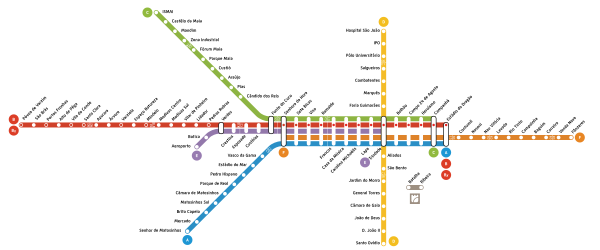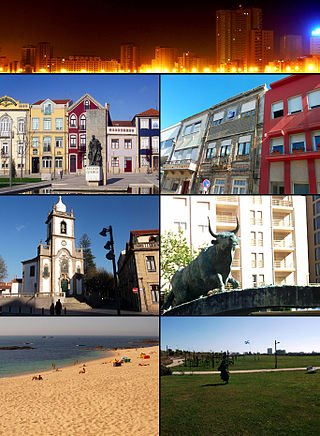
Póvoa de Varzim is a Portuguese city in Northern Portugal and sub-region of Greater Porto, 30 km (18.6 mi) from its city centre. It sits in a sandy coastal plain, a cuspate foreland, halfway between the Minho and Douro rivers. In 2001, there were 63,470 inhabitants, with 42,396 living in the city proper. The city expanded southwards, to Vila do Conde, and there are about 100,000 inhabitants in the urban area alone. It is the seventh-largest urban agglomeration in Portugal and the third largest in Northern Portugal.

Vila do Conde is a municipality in the Norte Region of Portugal. The population in 2011 was 79,533, in an area of 149.03 km2. The urbanized area of Vila do Conde, which includes the parishes of Vila do Conde, Azurara and Árvore, represent 36,137 inhabitants. Vila do Conde is interlinked to the north with Póvoa de Varzim, forming a single urban agglomeration which is a part of the Porto Metropolitan Area. The town is on the Portuguese Way of the Camino de Santiago.

The Porto Metropolitan Area is a metropolitan area in northern Portugal centered on the City of Porto, Portugal's second largest city. The metropolitan area, covering 17 municipalities, is the second largest urban area in the country and one of the largest in the European Union, with a population in 2021 of 1,737,395 in an area of 2,040.31 km².

Francisco Sá Carneiro Airport or simply Porto Airport is an international airport near Porto (Oporto), Portugal. It is located 11 km (6.8 mi) northwest of the Clérigos Tower. Its location is split between the municipalities of Maia, Matosinhos and Vila do Conde. The airport is run by ANA – Aeroportos de Portugal and is currently the second-busiest in the country, based on aircraft operations; and the second-busiest in passengers, based on Aeroportos de Portugal traffic statistics, after Lisbon Airport and before Faro Airport. The airport is a base for easyJet, Ryanair, TAP Air Portugal and its subsidiary TAP Express.

Trindade is a station on the Porto Metro system in Porto, Portugal and a former passenger rail station on the Linha do Porto à Póvoa e Famalicão and Linha de Guimarães of the Comboios de Portugal rail company.

Póvoa de Varzim' is served by a transportation network that employs maritime, aerial and terrestrial travel. The terrestrial access infrastructure is composed of national motorways (freeways), the national roads system, and light rail metro. These infrastructures and the airport, bus terminal, marina and harbour are daily used by commuters.

A native of Póvoa de Varzim in Portugal is called a Poveiro which can be rendered into English as Povoan. According to the 2001 Census, there were 63,470 inhabitants that year, 38 848 (61.2%) of whom lived in the city. The number goes up to 100,000 if adjacent satellite areas are taken into account, ranking it as the seventh largest independent urban area in Portugal, within a polycentric agglomeration of about 3 million people, ranging from Braga to Porto.

The Castelo da Póvoa, also Fortress of Póvoa de Varzim, officially Fortaleza da Nossa Senhora da Conceição or Nossa Senhora da Conceição Fortress, is a Portuguese fortress in Póvoa de Varzim rebuilt during the reigns of Peter II and John V to defend the town from privateers, in the site of an earlier fort known as "Forte de Torrão". It is considered a listed property of Public Interest in Portugal.

Senhora da Hora is a former civil parish in the municipality of Matosinhos in the Greater Porto area, Portugal. In 2013, the parish merged into the new parish São Mamede de Infesta e Senhora da Hora. It was promoted from town (vila) to city (cidade) status on 12 June 2009. It lies just north of the Porto city limits and is densely populated. It is a major suburban habitational area with many houses and some commerce.
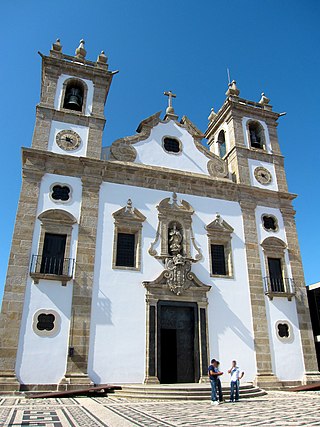
Matriz Church of Póvoa de Varzim, also Nossa Senhora da Conceição Parish Church is the Mother Roman Catholic church in Póvoa de Varzim, Portugal. The temple is located in Praça Velha square, in Bairro da Matriz quarter. The church is dedicated to the Our Lady of the Immaculate Conception, Nossa Senhora da Conceição in Portuguese, the main patron saint of Póvoa de Varzim.
The 2009–10 Taça da Liga was the third edition of the Taça da Liga, also known as Carlsberg Cup for sponsorship reasons. The first matches were played on 1 August 2009. The final was played on 21 March 2009, with Benfica defeating Porto 3–0 to win their second Taça da Liga. The final was played at the Estádio Algarve, Faro.
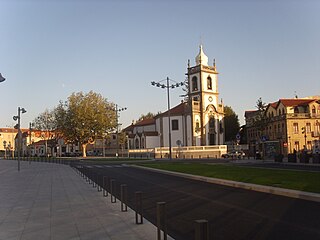
Largo das Dores or Dores Square is a square in Póvoa de Varzim city center in Portugal. Part of the earliest old town of Póvoa de Varzim, this area is listed by City Hall as heritage site. With about 11.000 square meters, its most noticeable features are its two churches, located in the sites of ancient chapels, one of which was the main church of the city.

The tram system of Porto in Portugal is operated by the Sociedade de Transportes Colectivos do Porto (STCP) and currently has three regular tram routes with 30-minute headways. All are heritage tram routes, as they use vintage tramcars exclusively, and should not be confused with the modern Porto Metro light rail system.

Ramal de Matosinhos, originally called Ramal de Leixões, was a metre-gauge railway line which connected the stations of Senhora da Hora, on the Linha do Porto à Póvoa e Famalicão, to the Port of Leixões, in Portugal. It was built in 1884 to connect the port to the São Gens quarry. Later, it was adapted to passenger and freight transport. Commercial service began on the 6 May 1893. The line was closed on 1 July 1965. In the 2000s, part of the trackbed was used for the construction of Porto Metro Line A.
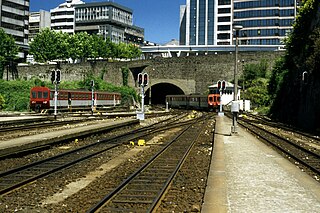
Linha do Porto à Póvoa e Famalicão was a railway line in Portugal, which connected Porto-Trindade to Póvoa de Varzim and Famalicão. The first section, from Porto-Boavista to Senhora da Hora, was opened on 1 October 1875, having been the first narrow-gauge line in the country. It was completed on 12 June 1881.






